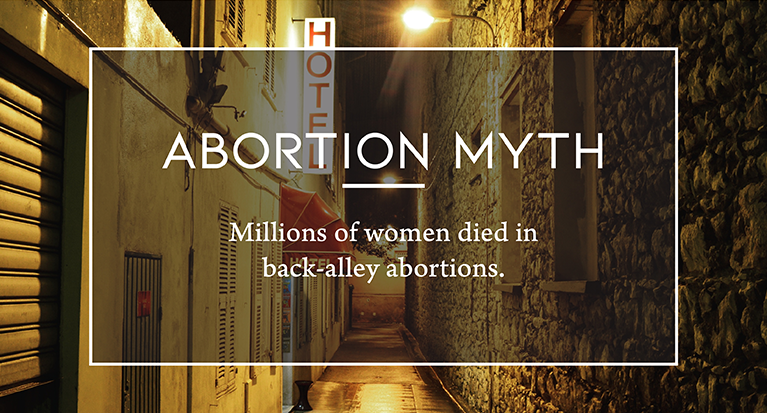So much of the abortion debate is based on myths, bad assumptions, bad logic, or outright gaslighting through deception. For the rest of 2019 we will highlight one common abortion myth every month.
#2: Millions of women died in back alley abortions.
The bottom line: Using false numbers and tactics of fearmongering to keep abortion legal does not benefit women.
Comments made this year by Leana Wen, the former president of Planned Parenthood, are an example of this myth in action. She stated: “Before Roe v. Wade, thousands of women died every year.” The Washington Post, which is by no means a prolife outlet, pointed out the falsity of such comments: “Even given the fuzzy nature of the data and estimates, there is no evidence that in the years immediately preceding the Supreme Court’s decision, thousands of women died every year in the United States from illegal abortions.”
Back-alley abortions were not as prevalent as they were claimed to be. Frightful stories of coat-hanger abortions are used by pro-abortion advocates to fearmonger and persuade public opinion in favor of keeping abortion legal. Abortion supporters frequently argue that having abortion be “safe, legal, and rare” would be better than the occurrence of dangerous, illegal, and back-alley operations.
Bernard Nathanson, a former abortionist and the co-founder of the National Abortion Rights Action League (NARAL Pro‑Choice America), was an early propagator of the back-alley abortion myth. Concerning the use of statistics of 5,000 to 10,000 deaths a year, Nathanson stated, “I confess that I knew the figures were totally false, and I suppose the others did too if they stopped to think of it. But in the ‘morality’ of our revolution, it was a useful figure, widely accepted, so why go out of our way to correct it with honest statistics? The overriding concern was to get the laws eliminated, and anything within reason that had to be done was permissible.”
The mental image of abortions accomplished with a coat hanger or the use of other unsanitary and gruesome manners to rid the child from the mother’s womb are useful to move audiences. However, those were generally not the practices used in the illegal abortions obtained before 1973. Nor was it unlicensed, ill-equipped quacks who were performing abortions prior to 1973. In 1960, Mary Calderone, a former medical director of Planned Parenthood, stated that nearly 90% of illegal abortions were performed by physicians in good-standing.
Abortions were not safe for women before 1973, yet neither have they been safe for women after the nationwide legalization of abortion. When considering historical and current abortion data, the logic of legalizing a practice in order to make it safe is empty.
Statistics reported by the Centers for Disease Control (CDC) demonstrate that fatalities of women who received illegal abortions do not add up to the thousands or millions of deaths claimed by pro-choice advocates. In 1972, the year before the legalization of abortion in the United States, the CDC reported that 39 women died from illegal abortion and 24 died from legal abortion. In 1973, the CDC reported 19 women died from illegal abortion procedures and 25 women died due to legal abortion procedures. Legalizing abortion did not lead to a dramatic drop in women’s deaths. In fact, the most impressive drop in abortion mortality was connected to the invention and widespread distribution of antibiotics, which occurred years prior to the legalization of abortion. Before antibiotics, childbirth and any type of surgery was extremely dangerous relative to today.
Restrictive abortion laws do not cause harm to the safety and health of women having abortions. In fact, the maternal mortality rate is higher in the United States than in many countries with stricter abortion restrictions. Abortion has been illegal in Ireland (until 2018), and Poland contains some of the most restrictive abortion laws. In 1989, Chile passed a ban on induced abortions in every circumstance (until 2015) and has experienced continued reductions in maternal mortality since 1989. The countries of Ireland, Chile, Poland, and similar nations have some of the lowest mortality rates in the world according to the World Health Organization and the United Nations.
Historically, mortality rates from Sweden and Denmark can be compared to the United States. In Sweden, where abortion was legal, 250 maternal deaths from abortion per 100,000 women were reported from 1946-1948. In Denmark, where abortion was also legal, 195 deaths were reported per 100,000 women from 1940-1950. In the United States, where abortion was still illegal, 165 maternal deaths were reported per 100,000 women from 1940-1950. [C. Tietze & S.K. Henshaw, Induced Abortion: A World Review (1986), 107]
These historical examples further demonstrate that the myth of women dying from widespread back alley abortions is just that—a myth.
Every life lost is a tragedy. Sharing blatantly false propaganda about the deaths of women affected by abortion prior to 1973 demonstrates a lack of respect and concern for women.
The best way to save women’s lives is an advanced and well-functioning medical system, or encouraging healthy lifestyles, not dismembering unborn children in unlicensed and unregulated abortion facilities.
Myth Series:
#10: Late-term abortions are only for health problems
#9: Abortion is a small part of Planned Parenthood’s services
#8: Women pregnant through rape all have abortions
#7: Most women support abortion
#6: Late-term abortions are rare
#5: Prolife people don’t care about the baby after it’s born
#4: Abortion has no side effects for women
#3: Elective abortions are only legal in the first trimester.
